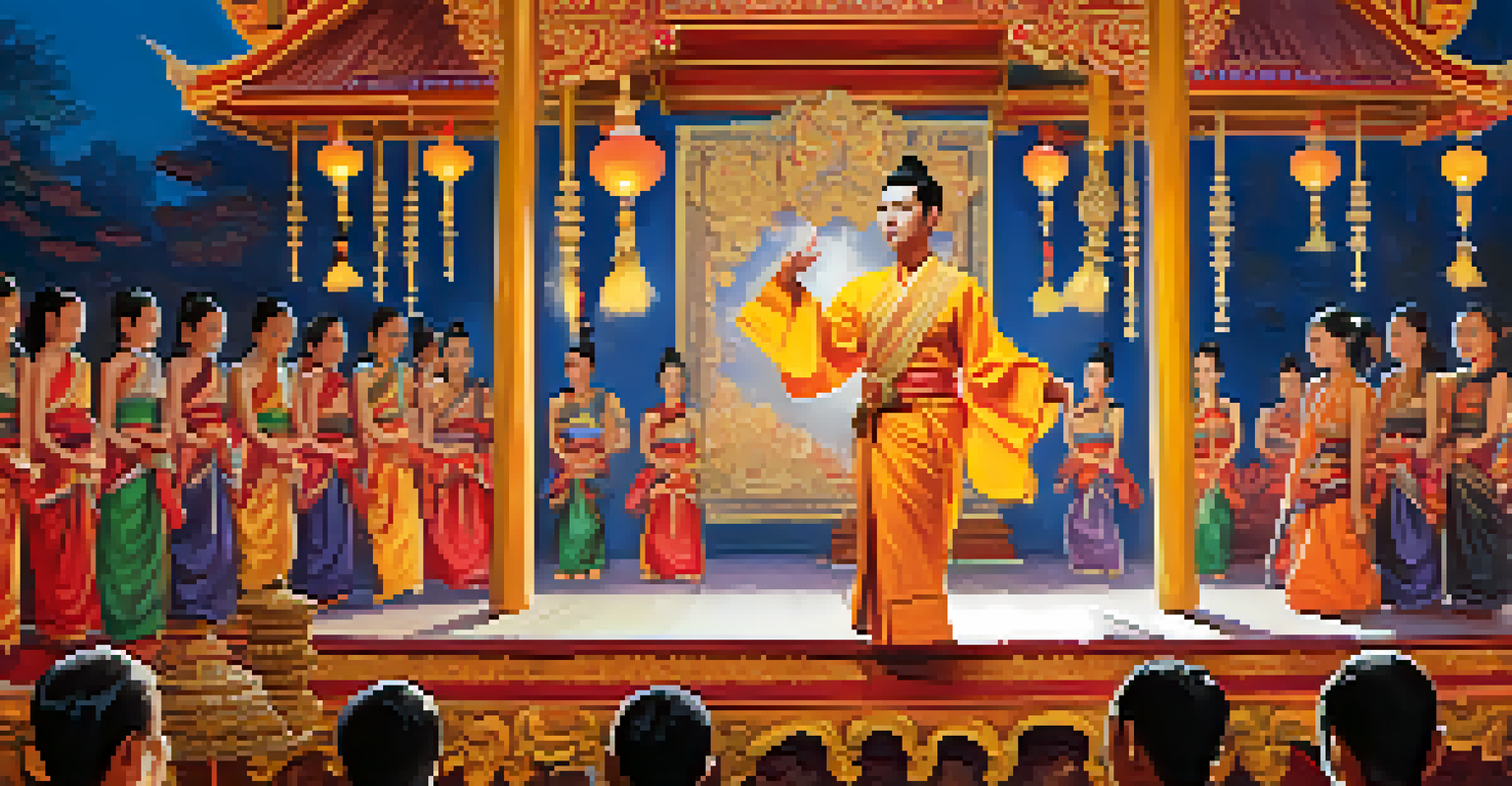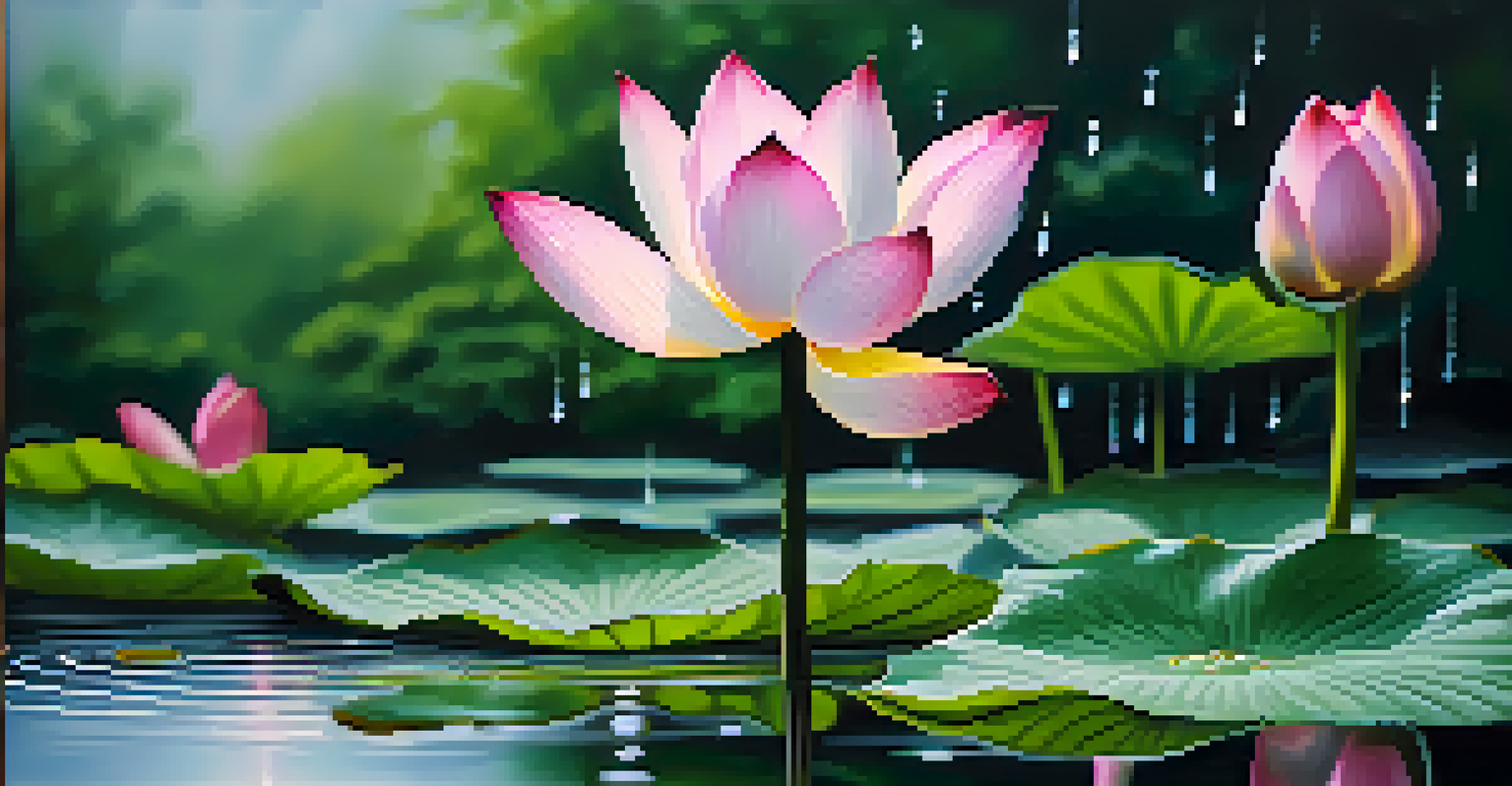Thai Poetry: A Reflection of Historical and Cultural Identity

The Historical Roots of Thai Poetry
Thai poetry has deep historical roots that date back centuries, intertwining with the development of the Thai language and culture. Early forms of poetry were often influenced by religious texts and royal patronage, showcasing the importance of literature in Thai society. This historical context not only highlights the artistry of Thai poets but also reflects the values and beliefs of their time.
Poetry is the language of the soul, expressing emotions that often elude everyday speech.
As Thailand transitioned through various kingdoms and influences, poetry evolved, adapting new styles and themes. For instance, the Ayutthaya period saw the emergence of the 'klon' form, characterized by its rhythmic structure and vivid imagery. These changes signify how poets responded to the shifting political and social landscapes, making their works a mirror of the times.
Ultimately, understanding the historical roots of Thai poetry provides insight into the cultural identity of the Thai people. It reveals how poetry has served as both a creative outlet and a means of preserving history, allowing future generations to connect with their past.
The Influence of Religion and Spirituality
Religion plays a pivotal role in Thai poetry, with Buddhism being the most significant influence. Many poets draw inspiration from Buddhist teachings, weaving themes of impermanence, meditation, and enlightenment into their verses. This spiritual dimension adds depth to the poetry, inviting readers to reflect on their own lives and beliefs.

Additionally, religious festivals and rituals often inspire poetic works, showcasing the rich tapestry of Thai spirituality. For example, during Loy Krathong, poems celebrating the beauty of water lanterns symbolize the release of negative energy, intertwining cultural practices with poetic expression. This fusion illustrates how poetry serves as a vehicle for spiritual and cultural reflection.
Historical Roots Shape Thai Poetry
Thai poetry has evolved over centuries, reflecting the cultural and social changes in Thailand's history.
Through the lens of religion, Thai poetry not only captures the essence of spiritual beliefs but also fosters a sense of community. It connects individuals to shared values and traditions, reinforcing cultural identity in an ever-changing world.
Nature and Its Symbolism in Thai Poetry
Nature has always held a significant place in Thai poetry, often serving as a backdrop for exploring human emotions and experiences. Poets frequently utilize imagery from the lush landscapes, vibrant flowers, and serene waters of Thailand, creating a rich sensory experience for readers. This connection to nature not only enhances the aesthetic quality of the poetry but also reflects the harmony between humans and the environment.
The beauty of poetry is that it allows us to explore the depths of our identity and the essence of our culture.
Moreover, natural elements in Thai poetry often symbolize deeper meanings, such as love, loss, and the passage of time. For instance, the lotus flower may represent purity and resilience, while the river might symbolize life's journey. Such symbolism enriches the reader's understanding, allowing them to draw personal connections to the themes presented.
By weaving nature into their verses, Thai poets invite readers to appreciate the beauty of their surroundings while contemplating their own lives. This relationship between poetry and nature fosters a sense of belonging and identity, grounding the cultural narrative in the physical world.
Modern Themes in Contemporary Thai Poetry
Contemporary Thai poetry reflects the complexities of modern life, addressing themes such as social justice, identity, and globalization. Poets today often explore issues of personal and collective identity, grappling with the challenges posed by rapid societal changes. This evolution in themes showcases how poetry remains a relevant and powerful form of expression.
Additionally, modern Thai poetry incorporates influences from various cultures, blending traditional elements with contemporary styles. This fusion allows poets to experiment with language and form, creating a dynamic landscape that resonates with diverse audiences. As a result, contemporary poetry often reflects a global perspective while maintaining a distinct Thai identity.
Nature Symbolism Enriches Verses
Natural imagery in Thai poetry symbolizes deeper themes, enhancing emotional connections and cultural identity.
Through these modern themes, Thai poetry continues to serve as a platform for dialogue and reflection. It encourages readers to engage with pressing issues, fostering a deeper understanding of the complexities of Thai society and culture.
The Role of Performance in Thai Poetry
Performance is a vital aspect of Thai poetry, transforming written verses into dynamic experiences. Poets often engage in live readings or incorporate their works into traditional dance and theater, bringing the poetry to life. This performative element enhances the emotional impact of the poetry, allowing audiences to connect with the words on a deeper level.
Moreover, performance poetry creates a communal atmosphere where listeners can share in the experience. Events such as poetry slams or cultural festivals showcase the talents of various poets, fostering a sense of camaraderie and cultural pride. This interaction between performers and audiences further enriches the cultural identity expressed through poetry.
As a living art form, the performance of Thai poetry highlights the importance of oral tradition in preserving cultural heritage. It ensures that the words continue to resonate within the community, bridging the gap between past and present.
Influential Thai Poets and Their Contributions
Throughout history, many Thai poets have made significant contributions to the literary landscape, shaping the way poetry is perceived and valued. Poets like Sunthorn Phu, often regarded as Thailand's Shakespeare, infused their works with rich imagery and profound themes, leaving a lasting legacy. His ability to capture the essence of Thai life through poetry continues to inspire future generations.
In addition to historical figures, contemporary poets such as Angkarn Kalayanapong and Chira B. S. have emerged, pushing the boundaries of traditional poetry. Their innovative styles and exploration of modern themes reflect the evolving nature of Thai poetry, ensuring it remains relevant in today's society. By giving voice to diverse experiences, these poets contribute to a broader understanding of Thai culture.
Modern Themes Reflect Current Issues
Contemporary Thai poetry addresses social justice and identity, showcasing the art's relevance in today's rapidly changing society.
The influence of these poets extends beyond their written works; they also inspire a new wave of writers and artists in Thailand. By celebrating their contributions, we acknowledge the vital role poetry plays in shaping cultural identity and its power to connect individuals across generations.
The Global Impact of Thai Poetry
Thai poetry has garnered international attention, showcasing the richness of Thai culture to the world. As translations of Thai poems become more accessible, readers from different backgrounds can appreciate the unique perspectives and artistry of Thai poets. This global interest not only highlights the universal themes present in the poetry but also fosters cultural exchange.
Furthermore, international poetry festivals and collaborations have provided Thai poets with platforms to share their voices. These opportunities allow them to engage with poets from around the world, enriching their own work while promoting Thai culture on a global stage. This exchange of ideas and styles contributes to the evolution of poetry as a whole.

Ultimately, the global impact of Thai poetry serves to strengthen cultural identity while bridging gaps between communities. It encourages a deeper appreciation of diverse voices, reminding us of the shared human experience that transcends borders.